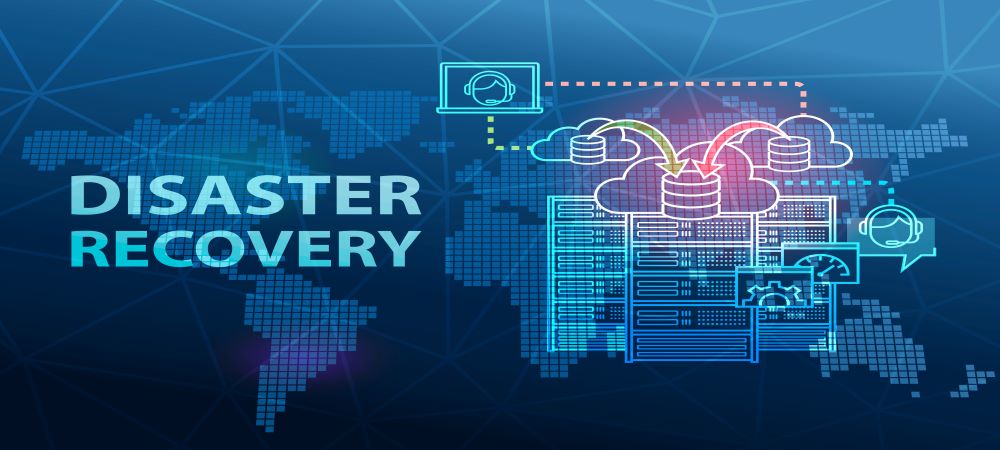A Disaster Recovery plan (DRP) is a documented, structured approach that describes how an organisation can quickly resume work after an unplanned incident. A DRP is an essential part of a Business Continuity plan (BCP). It is applied to the aspects of an organisation that depend on a functioning IT infrastructure. A DRP aims to help an organisation resolve data loss and recover system functionality so that it can perform in the aftermath of an incident, even if it operates at a minimal level. The feature will look at a step-by-step plan, precautions organisation should take to minimise the effects of a disaster, Disaster Recovery planning, business impact analysis (BIA) and how to establish recovery objectives.
No one likes to think about the possibility of a disaster, but when it comes to your business, it’s better to be safe than sorry. Having a plan in place for IT Disaster Recovery is essential to keeping your business up and running in the event of an unexpected outage. There are a few key things to keep in mind when preparing your Disaster Recovery plan. First, you need to identify what type of disasters could potentially impact your business. This could include anything from a power outage to a natural disaster. Once you’ve identified the risks, you can then start to put together a plan for how to recover from them. This might involve backing up data and having alternate systems in place for critical functions. The most important thing is to make sure that your plan is well-documented and regularly tested so that you can be confident that it will work when you need it.

Tony Bell, Chief Sales Officer, Sales and Marketing, Decision Inc Group, said over the past few months, the world has been facing an unprecedented crisis as the COVID-19 pandemic has wreaked havoc on countless communities around the globe. “Now that healthcare systems and facilities have been badly strained, many people and businesses have been looking for new ways to recover from disasters caused by this pandemic. As a result, there has been a major shift in the Disaster Recovery solutions market, with new products and services emerging to meet this demand. These innovations range from medical supplies to virtual communication platforms, all of which have become vital tools in helping people and communities recover from this public health emergency,” he said. “In short, it is clear that while COVID-19 may be causing damage on a global scale, its impacts are also sparking a whole new era of innovation in the Disaster Recovery solutions market.”
Gregg Petersen, Regional Director – MEA, Cohesity, said over the last two years, companies have had to carefully revaluate their Business Continuity plans. Petersen said the wave of digitalisation, propelled by the pandemic, has also made evident just how much of an impact any downtime and disruption of digital services can have. “The value of data in informing business decisions, identifying new revenue opportunities, and enhancing services for customers has also been exemplified in this period. Consequently, there is a greater sense of urgency around the need for next gen data management offerings that can enable IT to recover quickly and deliver business outcomes during their biggest crisis: a cyberattack,” he said.
Petersen said in the past, most organisations worried about natural disasters like floods, hurricanes, large-scale power outages, or even human error, but today, the threat has evolved to be much more nefarious with the rise of ransomware.
According to research by Cybersecurity Ventures, every 11 seconds a business falls victim to ransomware. “This is now the most serious concern,” noted Petersen. “While outages, disasters, and cyberattacks are unpredictable, they certainly aren’t unforeseen, prompting the need for all enterprises to build robust Disaster Recovery (DR) strategies. Fortunately, where traditional DR implementations were complex and expensive to maintain, today’s modern cloud and As-a-Service DR solutions unlock a host of benefits such as on-demand scaling, capacity-based pricing, and simplified operation.”
Bell said there are many different types of disasters that can strike an organisation, ranging from natural events like earthquakes and floods to human-caused issues like system crashes and data breaches.
He said CIOs need to be aware of all of these possible threats so that they can take appropriate steps to prepare for them. Some key considerations include designing backup power sources, training employees in disaster response procedures, and having detailed plans in place for recovery and restoration. “Additionally, it is important to work closely with other departments such as marketing and HR, who may have valuable insights into hazards that aren’t directly tied to IT systems. Overall, the best way for a CIO to ensure preparedness is to remain proactive, constantly monitoring for potential risks and building robust contingency plans for each one,” he said.
Bell said IT Disaster Recovery planning is a process that helps organisations prevent losses and minimise downtime in the event of an IT disaster.
He explained that the most common types of IT Disaster Recovery plans are backup and recovery plans, Business Continuity plans, and incident response plans. “Backup and recovery plans focus on protecting data and restoring systems after a disaster. Business Continuity plans focus on maintaining critical operations during and after a disaster. Incident response plans focus on identifying, responding to, and mitigating the effects of incidents,” he said. “IT Disaster Recovery planning is a critical part of any organisation’s risk management strategy. By taking the time to develop and implement an effective plan, organisations can greatly reduce the impact of an IT disaster.”
With CIOs and their IT teams being urged to carefully plan when going about building their Disaster Recovery plan, it is imperative that they approach this process with a critical plan.

Bell said IT Disaster Recovery planning is the process of creating a system that will allow an organisation to continue operating in the event of a major IT disaster. “The scope of Disaster Recovery planning can vary depending on the size and complexity of the organisation, but the objectives are generally the same: to minimise downtime, to protect data, and to ensure that critical business functions can continue,” he said. “To achieve these objectives, organisations need to have a comprehensive plan that covers everything from backup and recovery to communication and incident management. While it may seem like a lot of work, Disaster Recovery planning is essential for any organisation that relies on IT for its operations.”
Bell said when it comes to building a Disaster Recovery plan, CIOs and their IT teams need to approach the process with a critical mindset. “First and foremost, you need to be realistic about your organisational needs and capabilities. Second, you will need to carefully consider what aspects of your IT infrastructure are most crucial to keep running during a disaster. And finally, it’s important to identify any external factors that may have an impact on your DR plans,” he said. “Whether it’s internal politics or outside regulations, being aware of these factors will help ensure that your DR plan is able to meet the needs of your organisation under any circumstances. Ultimately, developing a comprehensive DR plan requires foresight, flexibility, and above all, attention to detail. So, if you’re looking for ways to build the best DR plan possible, just follow those simple tips!”
How should CIOs and their IT teams go about building their Disaster Recovery plan? According to Petersen, traditional Disaster Recovery implementations use a duplicate and mirroring approach and offer the advantage of near-zero downtime and fast recovery times that cannot be achieve with backup alone. However, said Petersen, the downside is that this approach requires an expensive secondary location, and entails the risk that malware could propagate and replicate because of near-sync replication. “CIOs should therefore consider the modern alternative – As-a-Service-based Disaster Recovery which enables them to use public cloud as their secondary infrastructure.
“With ransomware being one of the primary threat vectors, it’s also critical for a robust DR plan to also include backup – which can also be delivered As-a-Service. While DR solutions create separation by replicating data offsite, the near real-time nature of replication means infected or encrypted data may also get propagated as well. However, modern next gen data management solutions also provide immutability which means the backup data cannot be deleted or altered and this is critical in protecting an organisation’s data against ransomware,” he said.
Click below to share this article

